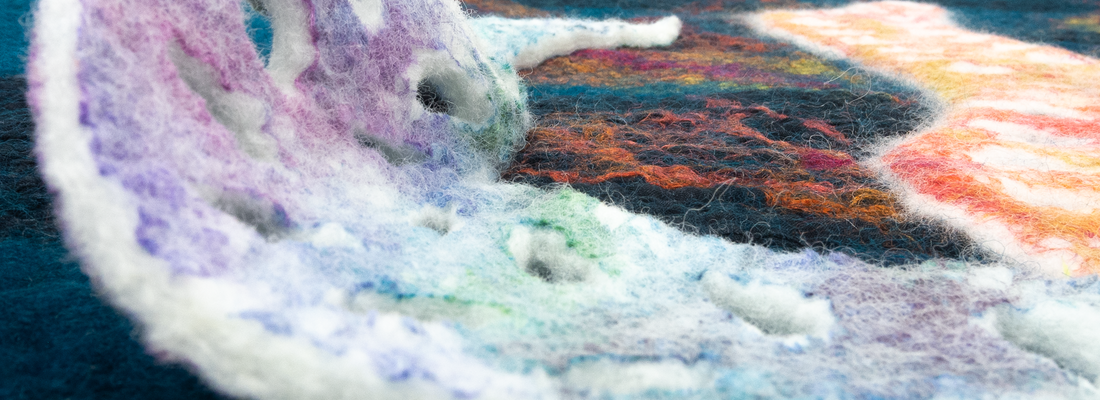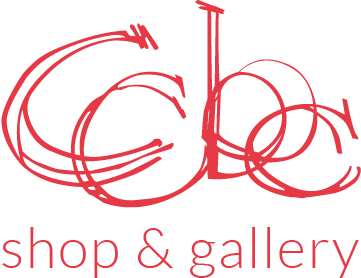
all about fibre
Share
Fibre is such a broad category, especially with the wide variety of materials artists have access to today. Brush up on your terminology before you start shopping for fibre craft, whether it be polyester or paper mache!
This post is an excerpt from pondercraft.ca, CCBC's educational website.
the material
The word "textile" comes from the Latin word texere, meaning "to weave". Textile, fabric and cloth are words that are generally interchangeable. They refer to anything made from fibres or fibrous materials.
Textiles are made by using either natural or synthetic fibres. Until the late 1800s, all textiles were made from natural fibres, including linen, cotton, silk, and wool. Today, many who work with natural fibres continue to collect, harvest, and clean their own raw materials as an integral part of the making process.
Industrialization and new technologies offer an ever increasing range of synthetic and natural fibres to the maker. Today, we also have synthetic fibres such as nylon, polyester and acrylic.
textiles

Identifying Features: Textiles are materials, composed of a woven, knitted, felted or chemically bonded network of either natural or artificial fibres. Depending on the source of the fibre, the texture, flexibility and workability may vary, making certain fibres more suitable for particular uses and needs.
Properties: Textiles come from a variety of different means in a variety of different forms of fibre. To list a few:
- Raw or natural fibres come from animals (ie. wool, silk, leather), minerals (ie. asbestos, much less common due to its health concerns from prolonged exposure), or plants (ie. hemp, sisal, cotton, soy, cedar, seagrass, linen, ramie, cellulose pulp). Natural fibres can be hand-worked or commercially spun into textiles.
- Processed or synthetic fibres include polyester, rayon or microfibers. Since synthetic fibres are artificial, they are typically identified as commercial fabrics (produced, processed and woven in factories alike).
Today, many textiles are clearly identified as to whether the fabric is new, or a recycled garment. As well, many more textile manufacturers are experimenting with recycled plastics and ethically sourced and spun fibres – concepts even embraced in many brand name fashion companies today.
paper
Identifying Features: Paper can appear in a variety of different textures and colours, from smooth to rough, soft to stiff, virtually any colour of the rainbow. So varied, that sometimes you may not even realize the material you are using is, in fact, a product made from plant fibres.
Properties: Paper is a plant-based product composed of hand-collected plant fibres; such as from wood or grasses. Plant fibres or cellulose pulp, are moistened and pressed together. Then, the pressed fibres are dried into flexible sheets, forming what we know as paper. The material can then be sculpted, layered, moulded and dyed.
leather

Identifying Features: Leather is a flexible material made of natural fibres. It comes in a variety of different natural shades (light to dark) depending on what tanning techniques and exposure the animal rawhide endures. Today, leather can be virtually any colour of the rainbow, died through artificial means for various fashion and commercial products.
Properties: Leather is favoured for its marriage between flexibility and extreme durability, subject to proper care. Leather is commonly made from cattle hide. However, some other natural sources include deer, ostrich and alligator, much more prevalent in the fashion industry where they are celebrated for their unique patterns. While leather has an excellent resistant to abrasion, it still requires its own protective precautions. High temperatures, humidity fluctuations, dust, pollution and insects can all degrade leather, shortening its lifespan. You can buy leather-friendly shampoos, oils and polishes at most grocery and leather stores to help prevent cracking, drying, etc.
As vegetarianism and veganism become increasingly popular, artificial leathers (Faux or Vegan Leather) are becoming more prevalent in the textile trade. While composed of artificial fibres, they can often pose quite similar to real leather goods. Thus, it is always important to check labels to ensure you know what you are buying, and how to care for your particular product.
Learn more about fibre and other craft mediums at ponder craft and design, CCBC's educational website.
cover image: "Free to be You and Me" - Monica Bennett
in-text: "Coral" Sculpture - Monica Bennett, Zen Leather Incense Holder - RG Handcrafted Goods
